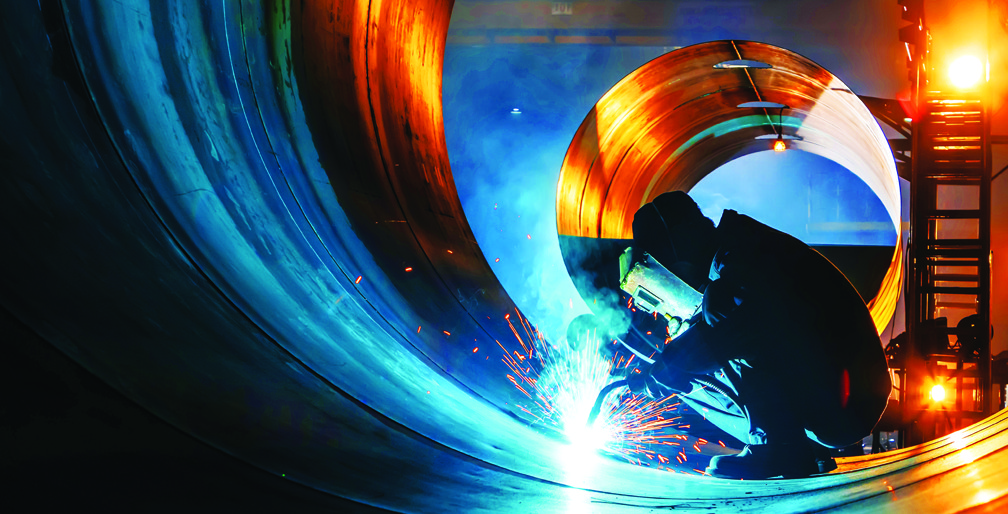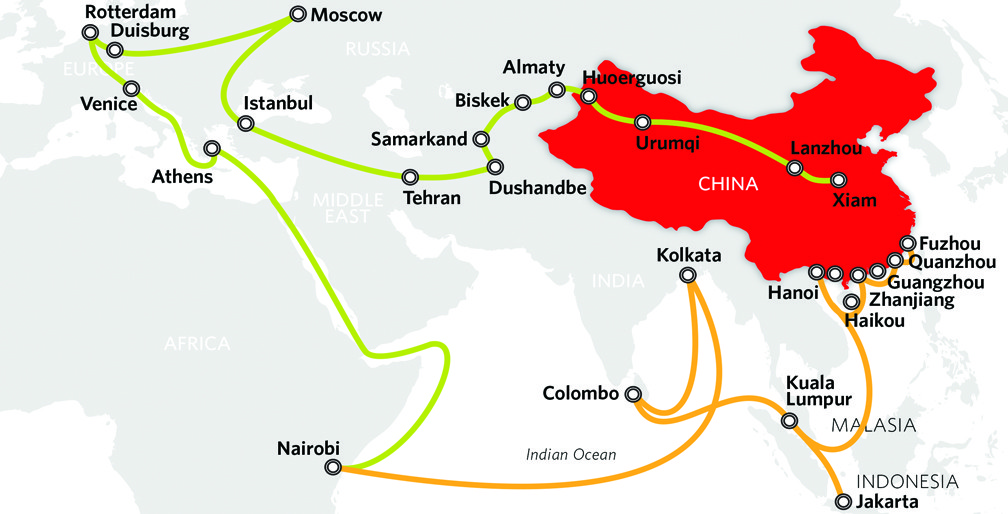China’s Belt and Road Initiative Is Transforming Global Commerce
Economic fortune has always been predicated on building systems and infrastructure that make trade easier. Whether it’s the ancient Silk Road that allowed people to move food, spices and fabrics or modern high-speed digital networking that carries packets of data, the ability to build paths to progress separates the winners from the losers.
China’s Belt and Road Initiative (BRI) is the latest in a long history of efforts to gain a competitive advantage. The initiative, which aims to modernize infrastructure in Asia and other parts of the world, focuses on constructing buildings, rail routes, roads, bridges, tunnels, dams, seaports and other projects. Funding for all of this falls between US$50 billion and US$100 billion annually.
At the center of BRI is a basic but profound concept. “It’s designed to facilitate trade, connectivity, economic cooperation and relations with countries around the world,” says Rebecca Nadin, PH.D., director of global risk and resilience at Overseas Development Institute in the U.K.
Indeed, the initiative, which could boost world GDP by $7.1 trillion per annum by 2040, promises to reshape the world. “It’s an enormous framework of commercial and political agreements, both legally and nonlegally binding.”
“In reality, BRI is more than an initiative that spans the old Silk Road from China to Europe. It’s global in scope. It’s best to think of it as a brand.” —David Dollar, a senior fellow at the Brookings Institution
Not surprisingly, the Belt and Road Initiative is generating waves that ripple around the world. As the initiative rolls out and gains momentum—it isn’t slated to end until 2049—it’s impacting everything from global financing and politics to digital systems and next-generation technologies. It also has spurred counterinitiatives, such as the Blue Dot Network, for which the U.S., Japan and Australia banded together to blunt the impact of BRI.
Says David Dollar, a senior fellow in foreign policy, global economy and development at the Brookings Institution, “In reality, BRI is more than an initiative that spans the old Silk Road from China to Europe. It’s global in scope. It’s best to think of it as a brand.”
The New Silk Road
Any discussion about the Belt and Road Initiative starts with a recognition that it’s an intentionally vague framework that ties together a vast array of projects. It’s fluid and constantly evolving. When Chinese president Xi Jinping formally announced BRI in 2013, it set in motion the largest and most ambitious infrastructure initiative in the history of the Eurasian region. The stated goal of the Chinese government is to loosely follow the old Silk Road, both on land and at sea, to drive economic development throughout the region—and beyond.
At present, 140 countries and 30 international organizations are involved in BRI in one form or another, with thousands of projects—on the drawing board or in progress—under the umbrella of the initiative. That’s a lot of moving parts, subject to changeable circumstances. Mr. Dollar says that the scope of BRI has expanded globally, including lending to countries such as Brazil, which has no natural connection to the Silk Road.
The stated purpose of BRI is to build infrastructure across two primary tracks and six main corridors. There’s a Silk Road Economic Belt with projects across various parts of Asia and into Europe. There’s a 21st-century Maritime Silk Road, which aims to spur development in Southeast Asia, Oceania and Africa. Key projects include high-speed rail lines in Kazakhstan, Russia, Belarus, Poland and Germany, and upgraded ports in Asia and Africa. The Belt and Road Initiative also encompasses many smaller projects, such as mining operations, electrical grids, factories and industrial parks.
China has also pushed the scope of the initiative into the Arctic. Its Ice Silk Road project, a partnership with Russia, aims to establish maritime routes through the Arctic region. As ice caps melt and new trade routes pen up between Asia and Europe, the two nations hope to gain economic advantage. Likewise, both recognize that vast and rich mineral resources, including precious metals, lie under the Arctic surface.
A Path to Progress
Although 2013 saw the official birth of the Belt and Road Initiative, the roots of the initiative extend back to at least the early 2000s, when China began to focus on building its economy and extending its reach globally. Around 2006, with a ballooning trade surplus and reserves near US$1 trillion, the country began to invest globally but found that returns weren’t particularly high.
As a result, it soon pivoted to the idea of lending money to other developing countries to build infrastructure, Mr. Dollar says. “Many of the pieces that formed the BRI were in place years before, and this initiative simply brought all of them together,” Dr. Nadin says.
China describes BRI as “a bid to enhance regional connectivity and embrace a brighter future.” Beyond these lofty and idealistic words lies an initiative that’s far more ambitious and expansive in scope and ideology. Besides an extensive and growing economic footprint, China believes that BRI will deliver benefits through cultural exchanges, mutual understanding and trust among member nations. This will result in “an innovative pattern of capital inflows, talent pools and technology databases.”
The Belt and Road Initiative, originally called “One Belt, One Road,” was added to the country’s constitution in 2017. Not surprisingly, as China has changed over recent years, so has BRI. It is increasingly focused on high-quality development, which reflects the nation’s overall path. China also has stated its desire to open the platform to all countries and investors. President Jinping promotes the idea that, like the original Silk Road that spread economic wealth, cultural understanding and ideas from the second century BC to the AD 15th century, BRI will blaze a trail further into the 21st century.
Despite all the optimism, the initiative raises nagging questions, particularly about developing nations taking on debt and about the environment. “Achieving the ambitions of the Belt and Road Initiative will require equally ambitious reforms from participating countries. Improvements in data reporting and transparency—especially around debt—open government procurement, and adherence to the highest social and environmental standards will help significantly,” writes Ceyla Pazarbasioglu, vice president for Equitable Growth, Finance, and Institutions at World Bank Group.

Banking on Debt
It should come as no surprise that the Belt Road Initiative has been met with both optimism and anxiety. As the World Bank noted in a 2019 report, Belt and Road Economics: Opportunities and Risks of Transport Corridors, “Many who see new business and trading opportunities from the initiative have touted its benefits for growth and development. Others have urged caution, noting significant risks.” This includes concerns about developing countries that might buckle under BRI-related debt.
The World Bank pointed out that while BRI transport projects are likely to expand trade, increase foreign investment and reduce poverty, the costs of new and upgraded infrastructure could in some cases outweigh the gains. Even successful projects could boost public debt, increase carbon emissions, promote corruption, displace communities and fuel social risks, it reported. Concerns have also surfaced about China exporting its environmentally costly and destructive development model.
To be sure, the initiative is somewhat contentious, particularly in the West. “The controversy is fueled by a lack of transparency that makes it difficult to get reliable information on the financing, as well as the specific projects and their terms,” Mr. Dollar says. In fact, some even call the BRI “debt trap diplomacy.” The concern is that smaller, less developed nations could wind up heavily indebted to China—and, presumably, under Beijing’s sphere of influence.
While some countries are more vulnerable to debt issues, Mr. Dollar says that these same countries are often attracted to China for two key reasons. “The U.S. and EU don’t do much public infrastructure financing anymore.” Second, Western firms can’t compete with Chinese firms on project pricing.
“The U.S. and EU are the gold standard or labor and environmental regulations,” Mr. Dollar explains. “A lot of developing countries welcome China, even if it’s riskier, because the overhead isn’t desirable at their stage of development. They’re also more comfortable working with the Chinese because the way they approach projects is similar.”
Meanwhile, David Scissors, a senior fellow at The American Enterprise Institute, uses the term “overhyped” to describe the BRI and many of the associated controversies. “Arguments that China is attempting to displace the U.S. as the global hegemon are not realistic,” he says. “There’s a certain amount of hysteria that China will lock out the West. They are simply pushing for more influence within the existing system.”

Riding the Silk Wave
As China’s economic influence grows, a realignment of global business ecosystems will emerge. Dr. Nadin says that it’s important to cut through the rhetoric and the political filter that’s often used to view—and sometimes disparage—China. She suggests that businesses take a broad and expansive view of the initiative. For example, BRI isn’t only about concrete and steel; it’s also about 5G cellular, fiber optic cabling and emerging digital technologies such as artificial intelligence, along with gaining a foothold in the Fourth Industrial Revolution.
The initiative is also “evolving on the green energy front,” she adds. In September 2021, President Xi Jinping informed the UN General Assembly that China would not build any coal-fired power stations abroad. Although it’s tempting to believe that Chinese businesses will be the sole beneficiaries of BRI, the reality is that all the various projects will generate economic activity around the world.
Businesses should stay tuned as the initiative unfolds—and look for openings and opportunities, Dr. Nadin says. “BRI is going to have different impacts on different sectors—and the initial infrastructure projects are only a starting point. In many cases, these projects will support additional business activities and trade,” she explains.
Mr. Dollar agrees that while that most of the projects are heavily tilted toward Chinese contractors and that few direct supply opportunities exist—the focus is heavily on Chinese equipment and steel—it’s crucial to take a broader view.
Mr. Dollar would like the focus to shift to greater transparency and a focus on human rights while the U.S. and other nations work to establish new and deeper trade agreements that would improve the investment climate for developing countries. This includes reducing red tape around infrastructure projects and offering more generous finance terms, including debt relief when and where it’s needed.
The Council on Foreign Relations suggests that the U.S. concentrate on enhancing its diplomacy and offering high-standard alternatives to BRI, as well as offering technical support to the Belt and Road Initiative countries. Other ideas include strengthening the World Bank, promoting U.S.-based digital transformation alternatives to the developing world, and expanding U.S. immigration for researchers, scientists and engineers.
In the end, one thing is clear: The Belt and Road Initiative will reshape global economics. According to the World Bank, success will ultimately hinge on policy reforms that increase transparency, expand trade, improve debt sustainability, and mitigate environmental and social risks, as well as the risk of corruption.
If China can check all the boxes, then BRI will be a gain for the world. If not, it could wind up as just another attempt to grab influence and power. Either way, BRI will make its mark. Says Mr. Dollar: “There’s an old Chinese adage: ‘To get rich, build a road.’ China is taking the concept into the 21st century.”
BRI Projects
(Not a complete list.)
China
The Central Asia-China Gas Pipeline passes through central Uzbekistan and southern Kazakhstan and ends in China’s Xinjiang Uighur Autonomous Region.
Kenya
Mombasa–Nairobi Standard Gauge Railway: 480 kilometers (roughly 300 miles).
Cambodia
Dam and hydropower facility with a total capacity of 2.715 billion cubic meters (7.172 billion gallons).
Russia
Yamal Liquefied Natural Gas (LNG). US$27 billion project producing 16.5 million metric tons of natural gas annually.
Indonesia
142-kilometer (88-mile) high-speed rail connecting Jakarta and Bandung.
Pakistan
Gwadar International Airport. US$246 million to build a new modern airport.
Hungary/Serbia
The $2.89 billion, 350-kilometer (217-mile) Budapest to Belgrade high-speed railway modernizes an existing rail line and connects the capitals of the two countries.



